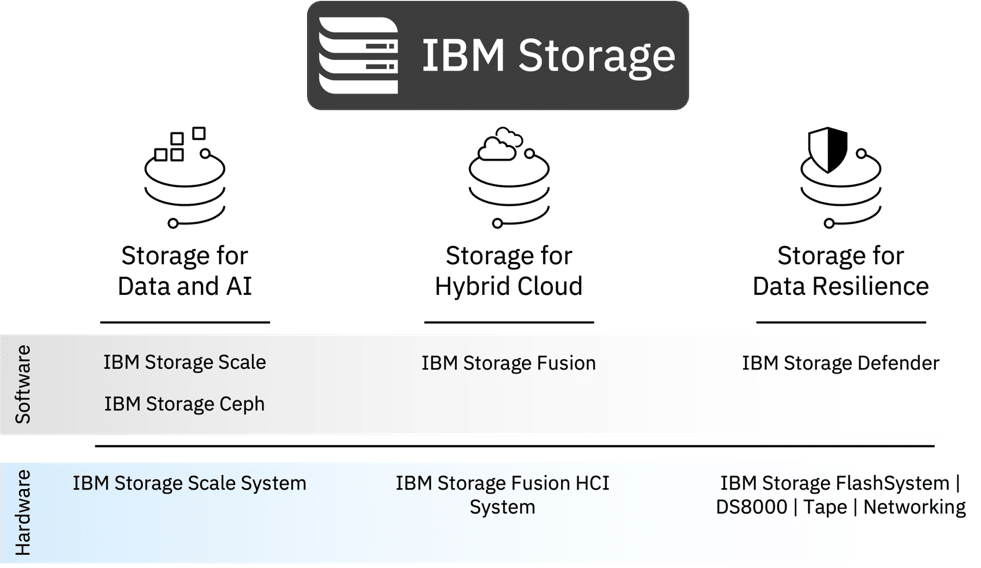During the past year, IBM has been changing its storage software portfolio to simplify navigating and understanding product offerings. To that end, IBM Spectrum becomes IBM Storage, reducing the number of products to a more manageable set focusing on software-defined, open, and consumable services.

Toward the end of 2022, IBM combined the Red Hat Storage software portfolio with IBM Storage to create a comprehensive Storage Software portfolio. IBM is investing heavily in open-source-based CEPH as the foundation for its software-defined storage platform. We covered the news when they announced IBM Hybrid Cloud Storage Folds in Red Hat Ceph and Red Hat OpenShift Data Foundation.
As IBM worked through digesting marketing research, customer interviews, and collaborating with industry experts, the result was to simplify the offerings by reducing the number of products and making it clear IBM is serious about the storage business.
IBM recognized that merely changing the name would only be sufficient with adding some substance behind the name change. After identifying the challenges facing its customers, IBM oriented its engineering, product, and marketing effort by creating a framework to address the top three challenges identified by customers:
- The adoption of AI at Enterprise Scale
- Digital Transformation of applications and services from Edge-to-core-to-cloud(s)
- Protecting business critical and operational workloads from the repetitional impacts and data loss associated with data breaches (accidental or intentional)

The above graphic depicts the new IBM Storage Solutions, Software, and Hardware Alignment
Address AI and Hyper-Data Growth
Designed to help customers get the most from their application and information supply chain to improve business outcomes. IBM Storage for Data and AI unlocks the latent value in data to fast-track innovation and business results. Customers can now eliminate the challenges associated with data ingest and aggregation, increase data relevancy, and enable faster data analysis at scale.
The solution is based on the following:
- IBM Storage Scale: scale-out file and object software-defined storage platform designed for AI, ML, and high-performance computing workloads.
- IBM Storage Ceph: unified and open-source software-defined storage platform designed to address general-purpose workloads’ block, file, and object needs.
- IBM Storage Scale System (formerly IBM Elastic Storage System): all-flash and hybrid elastic compute and storage appliance designed to create highly performant clusters for IBM Storage Scale in a sustainable IT architecture.
Connecting Edge-to-Core-to-Cloud(s)
Designed to help customers modernize their application stack and build next-generation applications and innovate faster with data orchestration services for Red Hat OpenShift. IBM Storage for Hybrid Cloud allows customers to deploy cloud architectures on-premises and extend them seamlessly to public cloud environments. This will help customers take control of their hybrid cloud environments and make IT more agile, scalable, secure, efficient, and cost-effective for their stateful container environment and portable workloads.
This solution is based on the following:
- IBM Storage Fusion: software-defined storage platform with flexible deployment options that deliver data orchestration services to efficiently store, protect, manage, govern, mobilize, and integrate data and applications hosted in Red Hat OpenShift environments.
- IBM Storage Fusion HCI System: purpose-built hyper-converged infrastructure that simplifies the design and deployment of Red Hat OpenShift with container-native data orchestration and storage services to enable faster and consistent Kubernetes architecture deployments.
Resiliency by Default, Resiliency by Design
Designed to help customers safeguard data from breaches and threats while reducing costs and downtime with resilient storage offerings. IBM Storage for Data Resiliency integrates machine learning and automation with storage technology to detect anomalies and threats, speed recovery, and optimize costs.
This solution is based on the following:
- IBM Storage Defender: reduce the threat exposure window from days to hours. Proactively safeguard data and applications with a multi-faceted and scalable data resiliency offering that defends against cyber vulnerabilities from detection through recovery with air-gapping capabilities that include logical, operational, and physical separation from source data sets.




 Amazon
Amazon